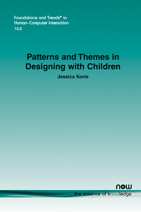Patterns and Themes in Designing with Children
By Jessica Korte, Co-Innovation Group, The University of Queensland, Australia, j.korte@uq.edu.au
Abstract
A host of design approaches have been developed to support involving children in the design of new technologies. Unique approaches tend to be developed to involve new “audiences” of children – of different ages, with different abilities, at different levels of involvement – in the design process. While goals of design approaches tend to be explicitly discussed, there are common themes and repeated patterns which appear in multiple design approaches. This monograph identifies these recurrent themes and patterns within design approaches for working with children as informants, design partners or software designers. These themes and patterns have been sorted into groups of: principles or heuristics, which act as guidelines to designers working with children; decision points where designers working with children will need to make choices; common activity patterns and communication patterns which appear frequently in design approaches for working with children, but are often under-described; and emergent phenomena which design approaches may attempt to invoke. These themes and patterns have been identified through comparison of methods and techniques for designing with children, young children, and children with a communication gap caused by disability or cross-cultural work.
This catalogue of themes and patterns will be of use for designers working with children in participatory design and co-design activities. Awareness of these factors will allow designers selecting existing design approaches, or creating their own, to better understand and compare existing design approaches.
Patterns and Themes in Designing with Children
User-centered design is an approach to designing technology that focuses on the needs of the user during design activities. When children are the target audience, this means designing for the needs, abilities, and expectations children have regarding technology. The key challenge, then, is how to design according to the actual needs, abilities, and expectations of children rather than the supposed needs and expectations reported by their adult representatives.
A host of design approaches have been developed to support involving children since the late 1960s. While the goals of design approaches tend to be explicitly discussed, there are common themes and repeated patterns that appear in multiple design approaches. This monograph identifies the significant or recurrent themes and patterns that can be identified across methods and techniques developed for designing with children. These themes provide useful tools and common language to analyse existing and aid in creating new design approaches. The emphasis is on papers that describe work with (young) children rather than teens, and children with communication gaps caused by disability or cross-cultural work.
Patterns and Themes in Designing with Children will be of use for designers working with children in participatory design and co-design activities. Awareness of the themes and patterns discussed in this monograph will allow designers selecting existing design approaches, or creating their own, to better understand and compare existing design approaches.

Online Appendix | 1100000079_app.pdf
This is the article's accompanying appendix.